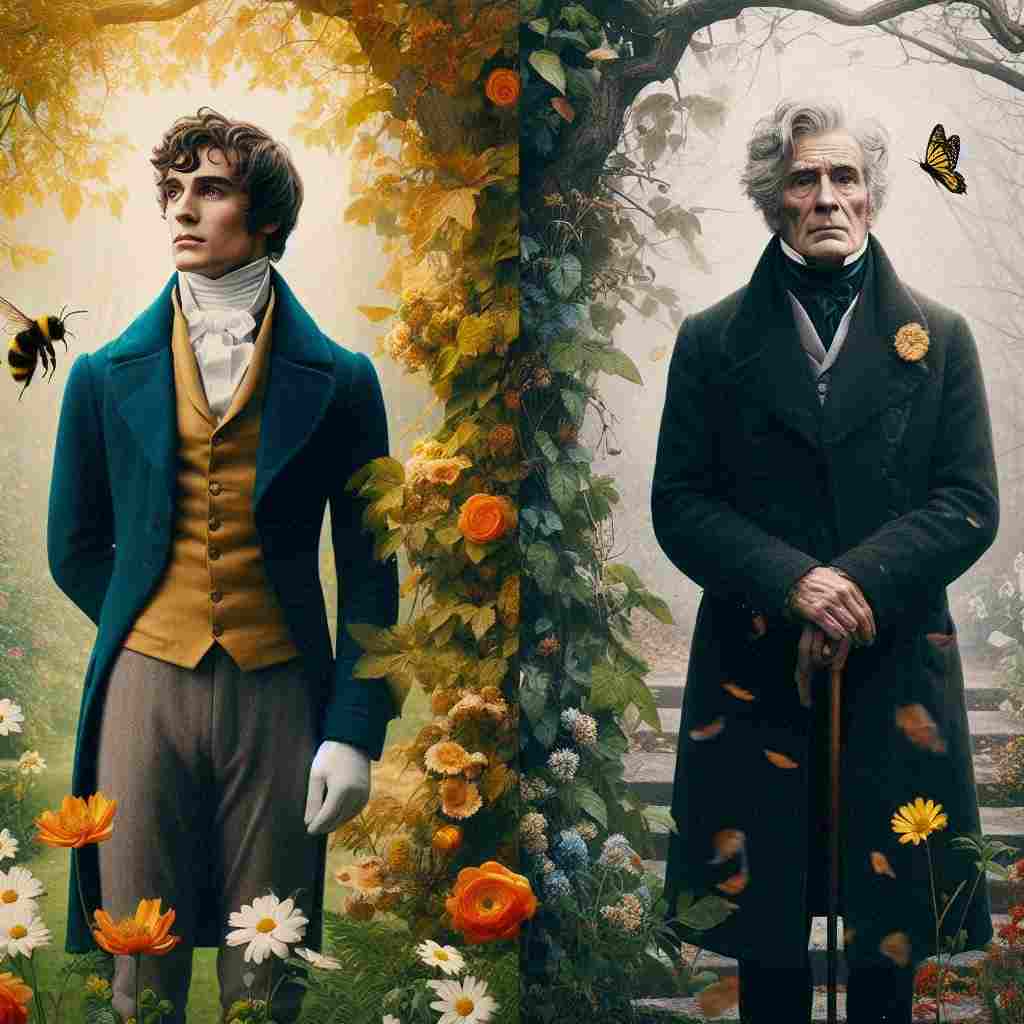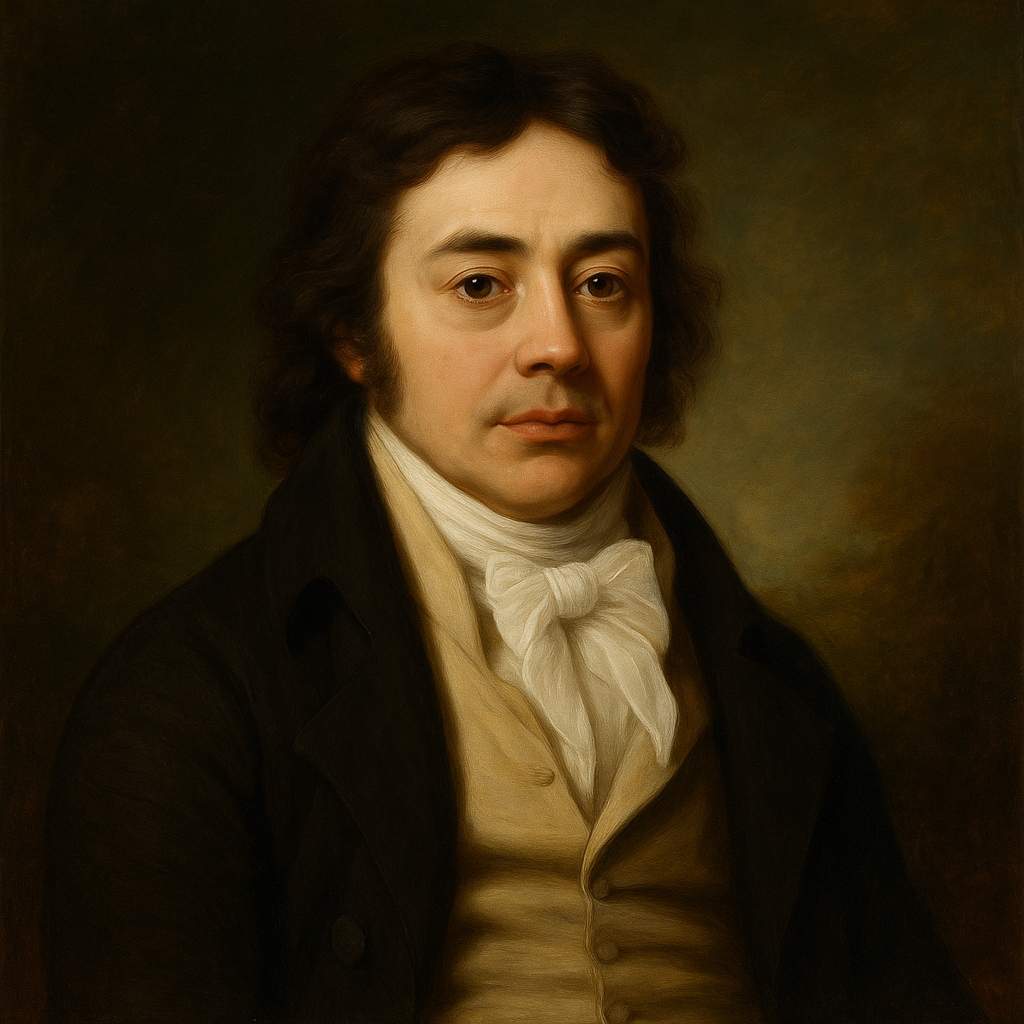Youth and Age
Samuel Taylor Coleridge
1772 to 1834

Verse, a breeze mid blossoms straying,
Where Hope clung feeding, like a bee—
Both were mine! Life went a maying
With Nature, Hope, and Poesy,
When I was young!
When I was young?—Ah, woful when!
Ah! for the change 'twixt Now and Then!
This breathing house not built with hands,
This body that does me grievous wrong,
O'er aery cliffs and glittering sands,
How lightly then it flashed along:—
Like those trim skiffs, unknown of yore,
On winding lakes and rivers wide,
That ask no aid of sail or oar,
That fear no spite of wind or tide!
Nought cared this body for wind or weather
When Youth and I liv'd in't together.
Flowers are lovely; Love is flower-like;
Friendship is a sheltering tree;
O! the joys, that came down shower-like,
Of Friendship, Love, and Liberty,
Ere I was old.
Ere I was old? Ah woful Ere,
Which tells me, Youth's no longer here!
O Youth! for years so many and sweet
'Tis known, that Thou and I were one,
I'll think it but a fond conceit—
It cannot be, that Thou art gone!
Thy vesper-bell hath not yet toll'd:—
And thou wert aye a masker bold!
What strange disguise hast now put on,
To make believe, that Thou art gone?
I see these locks in silvery slips,
This drooping gait, this altered size:
But springtide blossoms on thy lips,
And tears take sunshine from thine eyes!
Life is but thought: so think I will
That Youth and I are house-mates still.
Dew-drops are the gems of morning,
But the tears of mournful eve!
Where no hope is, life's a warning
That only serves to make us grieve,
When we are old:
That only serves to make us grieve
With oft and tedious taking-leave,
Like some poor nigh-related guest,
That may not rudely be dismist.
Yet hath outstay'd his welcome while,
And tells the jest without the smile.
Samuel Taylor Coleridge's Youth and Age
Introduction
Samuel Taylor Coleridge's "Youth and Age" stands as one of the most poignant meditations on the passage of time in the English Romantic canon. Composed during a period of physical decline and personal crisis in the 1820s, the poem weaves together the twin threads of youthful vitality and aged contemplation into a tapestry that is both deeply personal and universally resonant. This analysis will explore how Coleridge employs sophisticated metaphorical structures, careful prosodic choices, and a complex emotional register to create a work that transcends simple nostalgia to become a profound philosophical inquiry into the nature of time, memory, and consciousness itself.
Structural Analysis and Form
The poem's tripartite structure mirrors the psychological progression of its speaker through three distinct emotional and temporal states. The opening stanza, with its lilting rhythm and abundance of natural imagery, establishes youth as a state of perfect harmony between the internal and external worlds. The middle section introduces dramatic tension through its questioning stance, while the final movement resolves into a mood of resigned wisdom.
Coleridge's masterful manipulation of meter deserves particular attention. The poem's dominant iambic tetrameter creates a singing quality that recalls ballad form, but Coleridge frequently varies this pattern with strategic irregularities. Note how the refrain-like lines "When I was young!" and "Ere I was old" stand in isolation, their brevity emphasizing their emotional weight. This metrical variation serves both aesthetic and semantic purposes, creating what Coleridge himself termed "organic unity" between form and meaning.
Metaphorical Language and Natural Imagery
The poem's opening lines establish its central metaphorical framework: "Verse, a breeze mid blossoms straying, / Where Hope clung feeding, like a bee." This complex image merges the natural world with poetic creation, suggesting that in youth, artistic expression was as natural and effortless as the movement of wind through flowers. The bee image is particularly significant, as it combines purposeful activity (feeding) with the seemingly random movement of the breeze, capturing the paradoxical nature of youthful creativity.
Throughout the poem, Coleridge develops an intricate network of natural metaphors. "Friendship is a sheltering tree" presents one of the poem's most memorable images, suggesting both protection and organic growth. The progression from "blossoms straying" to "silvery slips" of hair charts the movement from spring to winter not just in natural terms, but in deeply embodied human experience.
The Body and Embodiment
One of the poem's most striking features is its treatment of the physical body, which Coleridge describes as "This breathing house not built with hands." This metaphor draws on Platonic and Christian traditions of the body as the soul's temporary dwelling, but Coleridge complicates this traditional imagery by emphasizing the body's autonomy: it "does me grievous wrong," suggesting a split between physical and spiritual existence that becomes more pronounced with age.
The description of youthful movement "O'er aery cliffs and glittering sands" contrasts sharply with the "drooping gait" and "altered size" of age. Yet Coleridge resists simple dualism by insisting on the interconnection of physical and mental states. The body that "cared" nothing for "wind or weather" in youth becomes inseparable from the speaker's consciousness in age.
Time and Memory
The poem's treatment of temporality is remarkably sophisticated. The speaker's repeated questioning of time markers—"When I was young?," "Ere I was old?"—suggests not just nostalgia but a fundamental uncertainty about the nature of temporal experience. The use of present tense in "Life is but thought" suggests an attempt to collapse temporal distance through the power of imagination.
Coleridge's handling of memory deserves particular attention. The poem doesn't simply recall youth; it actively questions the reliability and nature of such remembrance. The lines "I'll think it but a fond conceit— / It cannot be, that Thou art gone!" demonstrate a complex awareness of memory's capacity for self-deception, even as they assert its power to preserve and transform experience.
Voice and Dramatic Structure
The poem's dramatic structure is built around a dialogue between the speaker and personified Youth. This dialogue becomes increasingly complex as the poem progresses, moving from simple apostrophe ("O Youth!") to a more sophisticated questioning of Youth's "strange disguise." The suggestion that Youth might be a "masker bold" introduces an element of theatrical metaphor that complicates the poem's emotional trajectory.
The Role of Hope
Hope appears as both a literal and figurative presence throughout the poem. The opening image of Hope "feeding, like a bee" establishes it as an active, vital force in youth. Its absence in age—"Where no hope is, life's a warning"—creates the poem's darkest moment. Yet the speaker's insistence that "Life is but thought" suggests a possible transcendence of this despair through mental effort.
Social and Historical Context
Written during a period of significant personal and social change, the poem reflects broader cultural anxieties about aging in an increasingly youth-oriented Romantic culture. Coleridge's personal circumstances—his opium addiction, chronic illness, and sense of lost promise—inform the poem's emotional landscape without limiting its universal appeal.
The Poem's Ending
The poem's final image of the "poor nigh-related guest" who "tells the jest without the smile" represents a masterful fusion of social observation and personal feeling. The guest metaphor suggests both intimacy and alienation, while the jest without joy perfectly captures the hollow quality of forced cheerfulness in decline.
Conclusion
"Youth and Age" stands as one of Coleridge's most fully realized achievements, combining philosophical depth with emotional authenticity. Its sophisticated handling of time, memory, and embodied experience speaks to contemporary concerns while maintaining its historical specificity. Through its careful attention to form, its complex metaphorical structures, and its honest engagement with the experience of aging, the poem continues to offer readers a profound meditation on mortality and consciousness. Perhaps most importantly, it demonstrates how great poetry can transform personal experience into universal truth without sacrificing the particularity of individual feeling.
This text was generated by AI and is for reference only. Learn more
Want to join the discussion? Reopen or create a unique username to comment. No personal details required!



Comments
No comments yet. Be the first to comment!